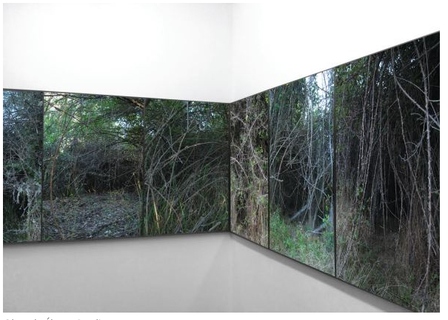Álvaro Perdices in "300 x 437 x 240" @ Casa Sin Fin, Madrid
On view through March 14, 2015 in Madrid, Spain.
Feb. 4, 2015
"300 x 437 x 240" goes beyond a documentary representation of nature, being easily subtitled as Zarzal, which translates into a wild (black berry) bush or thicket. It is a green mass that speaks of an anarchic and brutal landscape being brought to the comfortable landscape of the city —it is, in other words a certain representation of natural power— which becomes the evocation of natural disobedience and a non regulated gesture. The arms or branches of this bush grow everywhere, being quite difficult to handle, some will grow and superimpose over others, creating an ecosystem that becomes, at the same time, a nesting place for procreation and a camouflage environment for genets; a burrow for the protection and hiding, and the hunters’ watchtower to target their unsuspecting victims. It is definitely not a peaceful landscape. Although landscape is the framed representation of nature, which may be ideal or violent, I am interested in approaching the wild nature in a very traditional sense, almost pictorial, but framing it within the urban and regulated garden context, suddenly becoming this un-functional agitator element which may face the citizen, the pedestrian or the institutional.
The title of this project is the dimensions of the exhibition space. The work consists in a series of medium size lined up non sequential photographs next to each other, forming a 360 degrees diorama of wild vegetation. The title is also a sort of indication on how to install this piece, but it mainly points out a sculptural and perceptual frame where the photographic images have been taken from. The current space is small, concentrated, not quite the usual white box, and the dimensions of the images are exact and surround completely the spectator. If the work is installed in the future elsewhere, it would be interesting to reconstruct the entire gallery space with the same dimensions. In this sense, framing becomes a conceptual device that recalls specificity on the perceptual and sensorial space. At the Museo del Prado, for example, we see many works that were designed for specific spaces. Titian’s Poesie (Danae or Venus and Adonis) or the Bacchanals were destined for reserved and private spaces. However, the institution in its aim of public display, removes this private sensorial or erotic quality from works neutralizing part of their political aspects. As artists, we do not always have full control over the future of our works; on the other hand, the viewer becomes an important component to complete the piece, as the artist Nacho Criado commented external agents usually end finishing the work, and each viewer also becomes a different and receptive experience.
In these images, the wild bush creates, generates, and articulates uncanny holes and vortexes faces that extend the field of the affective reading, driving the unreal (but the real in the photographic object). These new images hint the dismembered from the black, from the darkness, leading us to another place, one that is not seen and draws us simultaneously… Holes nevertheless are places of mystery, of the anal, shit and pleasure: depending on our position, holes might be exiting places or entering paths.
The work is a place of resistance to the normative and what could be understood as trend. This resistance provokes precisely the possibility of “cracks” in the artist and in the viewer while generating other space/other experiences for knowledge, or paths to the not known. Sometimes is about dislocating a space, disengaging it in order to generate a different one, posing most times the same contents or questions into this displacement. The images that form this project in Casa Sin Fin, as the Black Photos series or Jakintza with the children sneaking out of the view, speak up on hiding. A sex drive if the darkrooms that eliminates the figure within the field of the monochrome, children who hide their bodies and faces, and a thicket where you do not get to see the end, where you can hide… I’m responding from the NO… The image does not give away what you want to see. It presents a metaphorical place from which “I see you but you don’t see me”, a hiding place in which it is possible to disobey and, as we know, a very particular form of pleasure grows in every act of disobedience.
Casa Sin Fin
C/Dr. Fourquet, 11
28102 Madrid, Spain
For more information, click here.





